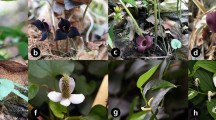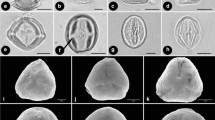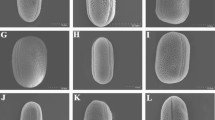Abstract
Pollen morphology of 19 taxa in Persicaria section Cephalophilon and four related taxa in the genus Koenigia was examined. Pollen grains shed as a monad were oblate to subprolate in shape (P/E = 0.50–1.20), small to large in size (13.44–51.16 μm), and tricolpate, octocolpate, or pantoporate. Three types of exine ornamentation were identified: (I) reticulate (P. sect. Cephalophilon), (II) reticulate with microechinae (Koenigia delicatula), and (III) microechinate (studied taxa of Koenigia except K. delicatula). The quantitative pollen characteristics analyzed using principal component analysis showed diagnostic importance among the taxa. The comprehensive consideration of pollen characteristics (aperture type, pollen size, and detailed exine ornamentation) is systematically informative, particularly at the series level of P. sect. Cephalophilon. Furthermore, the results also support the separation of some taxa of uncertain taxonomic affinities between Koenigia and P. sect. Cephalophilon. Orbicules were absent in all taxa of P. sect. Cephalophilon but were consistently found in Koenigia. The examined orbicules were spherical with a psilate surface, and the studied orbicule characteristics provided additional evidence to clarify the taxonomic position of some taxa of Koenigia. The orbicule and pollen morphology, especially aperture types, has proven to be a useful diagnostic characteristic in P. sect. Cephalophilon and related taxa, and their systematic importance is further discussed in this study.







Similar content being viewed by others
References
Ayodele AE (2005) The morphology and taxonomic significance of pollen in the West-African Polygonaceae. Thaiszia 15:143–153
Dulberger R (1992) Floral polymorphisms and their functional significance in the heterostylous syndrome. In: Barrett SCH (ed) Evolution and function of heterostyly monographs on theoretical and applied genetics. Springer, Berlin
Erdtman G (1960) The acetolysis method: a revised description. Svensk Bot Tidskr 54:561–564
Fan DM, Chen JH, Meng Y, Wen J, Huang JL, Yang YP (2013) Molecular phylogeny of Koenigia L. (Polygonaceae: Persicarieae): implications for classification, character evolution and biogeography. Molec Phylogen Evol 69:1093–1100. https://doi.org/10.1016/j.ympev.2013.08.018
Freeman CC, Reveal JL (2005) Polygonaceae. In: Flora of North America Editorial Committee (eds) Flora of North America, vol. 14, pp 216–601. Oxford University Press, New York
Galasso G, Banfi E, De Mattia F, Grassi F, Sgorbati S, Labra M (2009) Molecular phylogeny of Polygonum L. s.l. (Polygonoideae, Polygonaceae), focusing on European taxa: preliminary results and systematic considerations based on rbcL plastidial sequence data. Atti Soc Ital Sci Nat Mus Civico Storia Nat Milano 150: 113–148
Gross H (1913) Remarques sur les Polygonées l’Asie Orientale. Bull Acad Int Geogr Bot 23:7–32
Haraldson K (1978) Anatomy and taxonomy in Polygonaceae subfam. Polygonoideae Meissn. emend Jaretzky. Symb Bot Upsal 22:1–95
Hedberg O (1946) Pollen morphology in the genus Polygonum L. s.lat. and its taxonomic significance. Svensk Bot Tidskr 40:371–414
Hedberg O (1997) The genus Koenigia L. emend. Hedberg (Polygonaceae). Bot J Linn Soc 24:295–330. https://doi.org/10.1111/j.1095-8339.1997.tb01999.x
Hong SP (1994) Systematics of the genus Aconogonon (Polygonaceae – Persicarieae) in Himalaya and adjacent regions. Korean J Pl Taxon 24:195–213. https://doi.org/10.11110/kjpt.1994.24.3.195
Hong SP, Chung DH, Lee ST (1987) A palynotaxonomic study of the Korean Persicaria species. Korean J Pl Taxon 17:1–12. https://doi.org/10.11110/kjpt.1987.17.1.001
Hong SP, Hedberg O (1990) Parallel evolution of aperture numbers and arrangement in the genus Koenigia, Persicaria and Aconogonon (Polygonaceae). Grana 29:177–184. https://doi.org/10.1080/00173139009427750
Hong SP, Lee ST (1983) A palynotaxonomic study of the Korean Polygonaceae. Korean J Pl Taxon 13:63–76. https://doi.org/10.11110/kjpt.1983.13.2.063
Hong SP, Ronse Decraene LP, Smets E (1998) Systematic significance of tepal surface morphology in tribes Persicarieae and Polygoneae (Polygonaceae). Bot J Linn Soc 127:91–116. https://doi.org/10.1111/j.1095-8339.1998.tb02091.x
Hong SP, Oh IC, Ronse Decraene LP (2005) Pollen morphology of the genera Polygonum s. str. and Polygonella (Polygoneae: Polygonaceae). Pl Syst Evol 254:13–30. https://doi.org/10.1007/s00606-005-0334-4
Huysmans S, El-Ghazaly G, Nilsson S, Smets E (1997) Systematic value of tapetal orbicules: a preliminary survey of the Cinchonoideae (Rubiaceae). Canad J Bot 75:815–826. https://doi.org/10.1139/b97-091
Huysmans S, El-Ghazaly G, Smets E (1998) Orbicules in angiosperms: morphology, function, distribution, and relation with tapetum types. Bot Rev 64:240–272. https://doi.org/10.1007/BF02856566
Huysmans S, Verstraete B, Smets E, Chatrou LW (2010) Distribution of orbicules in Annonaceae mirrors evolutionary trend in angiosperms. Pl Ecol Evol 143:199–211. https://doi.org/10.5091/plecevo.2010.438
Kim ST, Donoghue MJ (2008) Molecular phylogeny of Persicaria (Persicarieae, Polygonaceae). Syst Bot 33:77–86. https://doi.org/10.1600/036364408783887302
Kong MJ, Hong SP (2018a) Comparative achene morphology of Persicaria sect. Cephalophilon and related taxa (Polygonaceae). Korean J Pl Taxon 48:134–142. https://doi.org/10.11110/kjpt.2018.48.2.134
Kong MJ, Hong SP (2018b) The taxonomic consideration of floral morphology in the Persicaria sect. Cephalophilon (Polygonaceae). Korean J Pl Taxon 48:185–194. https://doi.org/10.11110/kjpt.2018.48.3.185
Kong MJ, Hong SP (2019) Leaf micromorphology of the Persicaria sect. Cephalophilon (Polygonaceae) and its systematic re-evaluation. Phytotaxa 391:167–184. https://doi.org/10.11646/phytotaxa.391.3.1
Lamb Frye AS, Kron KA (2003) rbcL Phylogeny and character evolution in Polygonaceae. Syst Bot 28:326–332. https://doi.org/10.1043/0363-6445-28.2.326
Lau TC, Stephenson AG (1993) Effects of soli nitrogen on pollen production, pollen grain size, and pollen performance in Cucurbita pepo (Cucurbitaceae). Amer J Bot 80:763–768. https://doi.org/10.1002/j.1537-2197.1993.tb15292.x
Lee ST, Kim JG, Hong SP (1985) Pollen surface pattern and its taxonomic significance of the Korean Polygonaceae pollen. Korean J Pl Taxon 15:37–48. https://doi.org/10.11110/kjpt.1985.15.1.037
Li AJ, Kao T, Mao Z, Liu Y (1998) Polygonaceae. In: Li AJ (ed) Flora Republicae Popularis Sinicae, vol 25(1). Science Press, Beijing, pp 1–209
Li AJ, Bao B, Grabovskava-Borodina AE, Hong SP, McNeill J, Mosyakin SL, Ohba H, Park CW (2003) Polygonaceae. In: The Flora of China Editorial Committee (eds) Flora of China, vol. 5. Missouri Botanical Garden Press, Saint Louis, pp 277–350
Marinho RC, Mendes-Rodrigues C, Bonetti AM, Oliveira PE (2014) Pollen and stomata morphometrics and polyploidy in Eriotheca (Malvaceae-Bombacoideae). Pl Biol 16:508–511. https://doi.org/10.1111/plb.12135
Meisner CF (1832) Synopsis Polygonearum. In: Wallich N (ed) Plantae Asiaticae Rariores 3. Treuttel and Würtz, London, pp 53–65.
Moon HK (2018) The phylogenetic potential of orbicules in angiosperms. Korean J Pl Taxon 48:9–23. https://doi.org/10.11110/kjpt.2018.48.1.9
Moon HK, Hong SP (2015) Morphological traits of gynodioecious Persicaria amphibia (Polygonaceae). Phytotaxa 219:133–143. https://doi.org/10.11646/phytotaxa.219.2.3
Moon HK, Vinckier S, Smets E, Huysmans S (2008a) Comparative pollen morphology and ultrastructure of Mentheae subtribe Nepetinae (Lamiaceae). Rev Palaeobot Palynol 149:174–198. https://doi.org/10.1016/j.revpalbo.2007.12.001
Moon HK, Vinckier S, Smets E, Huysmans S (2008b) Palynological evolutionary trends within the tribe Mentheae with special emphasis on subtribe Menthinae (Nepetoideae: Lamiaceae). Pl Syst Evol 275:93–108. https://doi.org/10.1007/s00606-008-0042-y
Nowicke JW, Skvarla JJ (1979) Pollen morphology: the potential influence in higher order systematics. Ann Missouri Bot Gard 66:633–700. https://doi.org/10.2307/2398914
Paul P, Chowdhury M (2020) Pollen morphology of selected Indian species from subfamily Polygonoidae (Polygonaceae). Biologia 75:1083–1095. https://doi.org/10.2478/s11756-020-00449-3
Punt W, Hoen PP, Blackmore S, Nilsson S, Le Thomas A (2007) Glossary of pollen and spore terminology. Rev Palaeobot Palynol 143:1–81. https://doi.org/10.1016/j.revpalbo.2006.06.008
R Development Core Team (2020) R: A language and environment for statistical computing. R Foundation for Statistical Computing, Vienna, Austria. https://www.R-project.org/
Reddy NP, Bahadur B, Kumar PV (1977) Heterostyly in Polygonum chinense. J Genetics 63:79–82. https://doi.org/10.1007/BF02984278
Reitsma T (1969) Size modifications of recent pollen under treatments. Rev Palaeobot Palynol 9:175–202. https://doi.org/10.1016/0034-6667(69)90003-7
Ronse Decraene LP, Hong SP, Smet E (2000) Systematic significance of fruit morphology and anatomy in tribes Persicarieae and Polygoneae (Polygonaceae). Bot J Linn Soc 134:301–337. https://doi.org/10.1111/j.1095-8339.2000.tb02356.x
Ruggiero F, Bedini G (2018) Systematic and morphologic survey of orbicules in allergenic angiosperms. Aerobiologia 34:405–422. https://doi.org/10.1007/s10453-018-9522-x
Sanchez A, Schuster T, Burke J, Kron K (2011) Taxonomy of Polygonoideae (Polygonaceae): a new tribal classification. Taxon 60:151–160
Schuster TM, Reveal JL, Bayly MJ, Kron KA (2015) An updated molecular phylogeny of Polygonoideae (Polygonaceae): Relationships of Oxygonum, Pteroxygonum, and Rumex, and a new circumscription of Koenigia. Taxon 64:1188–1208. https://doi.org/10.12705/646.5
Sokal RR, Rohlf FJ (1995) Biometry: the principles and practice of statistics in biological research. Freeman and Company, New York
Song JH, Moon HK, Hong SP (2016) Pollen morphology of the tribe Sorbarieae (Rosaceae). Pl Syst Evol 302:853–869. https://doi.org/10.1007/s00606-016-1303-9
Song JH, Moon HK, Oak MK, Hong SP (2017a) Phylogenetic evaluation of pollen and orbicule morphology in Rosaceae tribe Neillieae (subfamily Amygdaloideae). Bot J Linn Soc 183:439–453. https://doi.org/10.1093/botlinnean/bow019
Song JH, Oak MK, Roh HS, Hong SP (2017b) Morphology of pollen and orbicules in the tribe Spiraeeae (Rosaceae) and its systematic implications. Grana 56:351–367. https://doi.org/10.1080/00173134.2016.1274334
Takhtajan A (2009) Flowering Plants, 2nd edn. Springer, New York. https://doi.org/10.1007/978-1-4020-9609-9
Thiers B (2020) [continuously updated] Index Herbariorum: A global directory of public herbaria and associated staff. New York Botanical Garden’s Virtual Herbarium, Bronx. https://sweetgum.nybg.org/science/ih/
Timson J (1965) A study of hybridization in Polygonum section Persicaria. Bot J Linn Soc 59:155–161. https://doi.org/10.1111/j.1095-8339.1965.tb00054.x
Verstraete B, Groeninckx I, Smets E, Huysmans S (2011) Phylogenetic signal of orbicules at family level: Rubiaceae as case study. Taxon 60:742–757. https://doi.org/10.1002/tax.603010
Verstraete B, Moon HK, Smets E, Huysmans S (2014) Orbicules in flowering plants: a phylogenetic perspective on their form and function. Bot Rev 80:107–134. https://doi.org/10.1007/s12229-014-9135-1
Vinckier S, Smets E (2001) The potential role of orbicules as a vector of allergens. Allergy 56:1129–1136. https://doi.org/10.1034/j.1398-9995.2001.00172.x
Walker JW, Doyle JA (1975) The basis of angiosperm phylogeny: palynology. Ann Missouri Bot Gard 62:664–723. https://doi.org/10.2307/2395271
Wang JX, Feng ZJ (1994) A study on the pollen morphology of the genus Polygonum in China. Acta Phytotax Sin 32:219–231 (in Chinese)
Wodehouse RP (1931) Pollen grains in the identification and classification of plants VI. Polygonaceae. Amer J Bot 58:749–764. https://doi.org/10.2307/2435790
Yasmin G, Khan MA, Shaheen N, Hayat MQ, Zafar M, Ahmad M (2010) Pollen morphological diversity in selected species of Persicaria Mill. (Family; Polygonaceae). J Med Pl Res 4:862–870. https://doi.org/10.5897/JMPR09.448
Yurteseva OV, Severova EE, Bovina IY (2014) Pollen morphology and taxonomy of Atraphaxis (Polygoneae, Polygonaceae). Pl Syst Evol 300:749–766. https://doi.org/10.1007/s00606-013-0917-4
Zhao DP, Wang KM, Hou YT (2012) Phylogeny of Polygonum sect. Cephalophilon (Polygonaeae) inferred from the chloroplast trnL-F, rbcL and nuclear ribosomal ITS sequences. Bull Bot Res Harb 32:77–83. https://doi.org/10.7525/j.issn.1673-5102.2012.01.013 (in Chinese)
Zhou ZZ, Zhang XP, Xu RX (2004) Pollen morphology of Koenigia from China. Acta Phytotax Sin 42:513–523 (in Chinese)
Zhu LT, Lu FJ, Hou YT, Li FZ (2007) Micro-morphology of leaf epidermis and its taxonomic significance of Polygonum section Cephalophilon. J Wuhan Bot Res 25:136–142 (in Chinese)
Acknowledgements
We are grateful to our colleagues, and the directors of the herbaria of K, KHUS, KUN, PE, and WU. We also thank editor and the two anonymous reviewers for their valuable comments and suggestions to substantially improve our manuscript.
Funding
The work was supported by grants from the Basic Science Research Program through the National Research Foundation of Korea (NRF) funded by the Ministry of Education, Sciences and Technology [Grant Numbers NRF-2018R1D1A1A09083715] to S.-P. Hong.
Author information
Authors and Affiliations
Corresponding author
Ethics declarations
Conflict of interest
The authors declare that they have no conflict of interest
Additional information
Handling Editor: Ferhat Celep.
Publisher's Note
Springer Nature remains neutral with regard to jurisdictional claims in published maps and institutional affiliations.
Supplementary Information
Information on Electronic Supplementary Material
Information on Electronic Supplementary Material
Online Resource 1. Voucher specimens that are examined in the present study.
Rights and permissions
About this article
Cite this article
Kong, MJ., Song, JH. & Hong, SP. Pollen morphology of Persicaria section Cephalophilon (Polygonaceae). Plant Syst Evol 307, 16 (2021). https://doi.org/10.1007/s00606-020-01738-9
Received:
Accepted:
Published:
DOI: https://doi.org/10.1007/s00606-020-01738-9




